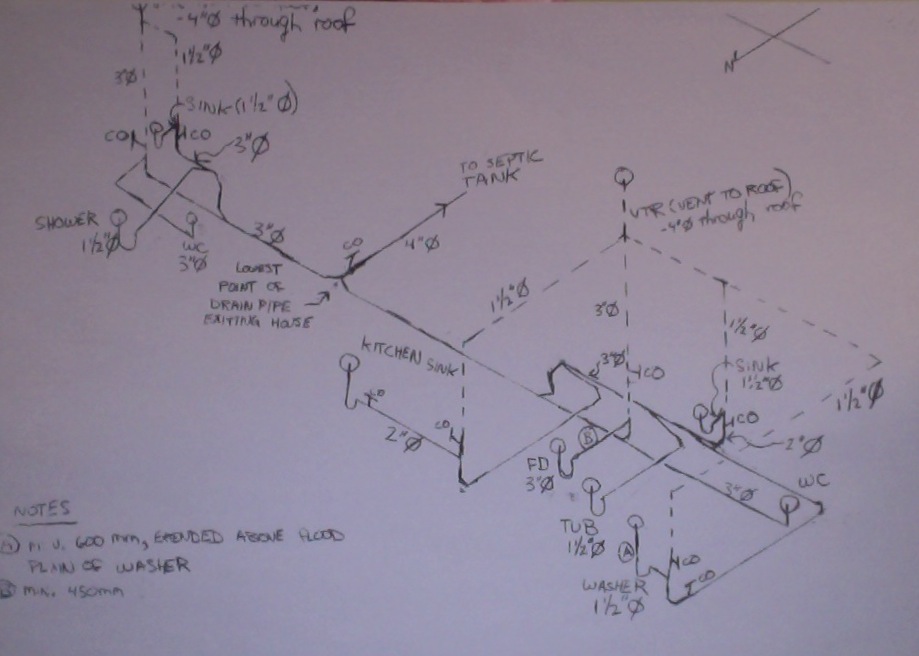
This post is an attempt to catch up with the technical details of our earthship construction activities of this summer … so bear with me as I will be touching on a number of different areas …
I wrote this post about a month ago but just got around to adding pictures and drawings today … there are many more pictures on our Facebook page.
Plumbing
Drains
We recently pulled our plumbing permit (end of July) for this project. Our approach has always been that we are building a code compliant septic system with the ability to divert the flow (using 3 way diversion valves) from specific plumbing fixtures (sinks, bathtub, shower, laundry) to our grey water system. The alternative approach would have been to design a grey water based system from scratch requiring input (and cost) from an appropriately code certified individual (engineer or certified waste water tech). Our plumbing permit is for a standard, BC Building Code compliant septic system that easily allows us to divert the grey water flows. This allows us to incorporate grey water into our building when the BC Building Code addresses gray water systems at some point in the future.
I have attached a copy of our plumbing permit isometric drawing to the top of this post. I suspect this drawing is a little difficult to interpret without looking at a plan view of the earthship showing the plumbing fixtures at the same time. (I have this drawing but still need to track down a jpeg of it … there is a floorplan drawing that may help in the photos section of the website.) To implement the grey water part of this system a seperate set of grey water drainage pipes were specified. In order to remain code compliant all of these grey water pipes ultimately flow into the black water drainage system. Three way diversion valves (we are using Jandy valves … which seem to be the most common choice for this work) allow for the flow to be sent in one of two directions; either to the septic or grey water system.
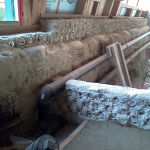 Our first implementation stumbling block occured from the use of these valves; the current plumbing code does not address grey water diversion. As such, we will not be installing these valves initially … for the time being the grey water pipes will flow directly into black water pipes where these valves will eventually go. This keeps our system code compliant and allows us to finish our grey water system when the BC Building Code is more clear on this topic. The photo attached to this paragraph shows the grey water line stacked on top of the black water line with a right angle fitting at the end joining these two lines … the right angle fitting will eventually be replaced with a Jandy valve.
Our first implementation stumbling block occured from the use of these valves; the current plumbing code does not address grey water diversion. As such, we will not be installing these valves initially … for the time being the grey water pipes will flow directly into black water pipes where these valves will eventually go. This keeps our system code compliant and allows us to finish our grey water system when the BC Building Code is more clear on this topic. The photo attached to this paragraph shows the grey water line stacked on top of the black water line with a right angle fitting at the end joining these two lines … the right angle fitting will eventually be replaced with a Jandy valve.
One struggle I found implementing this plumbing system was dealing with inconsistencies between tradiitional plumbing and grey water. In a grey water system the preference seems to be for smaller diameter pipes for better flow (ideally not larger than 2″). A typical plumbing system uses larger diameter pipes as the various black water flows are combined (typically 3 and 4″ diameter) … again for better flow when dealing with the solids encountered in a black water flow. We kept our largest grey water diversion pipe to 3″ (necessary to be code compliant for the septic system).
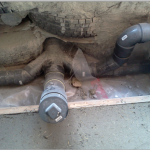 When we built our front tire wall we installed plumbing sleeves between the tires at the correct height to run the building septic drain line to our septic tank. Unfortunately, we did not place these sleeves in locations that simplified the plumbing system. We abandoned these sleeves and chose a new location for our building drain line to exit the building based on our final , submitted plumbing permit. In order to run this pipe through the front tire wall we had to bore a hole through one of the front wall tires. We used a sawzall to cut a hole of the desired size through the tire. We were able to cut the tire; we went through a lot of sawzall blades, and it was a very frustrating job. The vibration of the sawzall caused a substantial amount of the dirt packed into the tire to vibrate out of the hole that was being cut … after placing a sleeve for the plumbing pipe through the tire we re-packed the void in the tire with concrete. Moral of the story … think twice and lay plumbing sleeves once!
When we built our front tire wall we installed plumbing sleeves between the tires at the correct height to run the building septic drain line to our septic tank. Unfortunately, we did not place these sleeves in locations that simplified the plumbing system. We abandoned these sleeves and chose a new location for our building drain line to exit the building based on our final , submitted plumbing permit. In order to run this pipe through the front tire wall we had to bore a hole through one of the front wall tires. We used a sawzall to cut a hole of the desired size through the tire. We were able to cut the tire; we went through a lot of sawzall blades, and it was a very frustrating job. The vibration of the sawzall caused a substantial amount of the dirt packed into the tire to vibrate out of the hole that was being cut … after placing a sleeve for the plumbing pipe through the tire we re-packed the void in the tire with concrete. Moral of the story … think twice and lay plumbing sleeves once!
We laid out all of our grey water and septic lines that will be buried under the floor or run along the walls in the bathrooms.
Supply
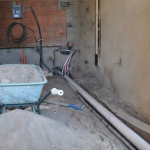 For the time being we only dealt with supply lines we are installing under the floor. We ran a number of 3/4″ PEX lines from the utility room to the main bathroom. To simplify this job we packed these lines into a 4″ diameter PVC conduit and bedded the conduit in screened gravel before burying it under the floor. Any hot water lines were wrapped in insulation before being placed in the conduit. The conduit was not strictly necessary; PEX can be directly buried under a slab and sleeved only where it comes through the slab … the conduit under the slab hopefully guarantees we will have no problems with these lines down the road.
For the time being we only dealt with supply lines we are installing under the floor. We ran a number of 3/4″ PEX lines from the utility room to the main bathroom. To simplify this job we packed these lines into a 4″ diameter PVC conduit and bedded the conduit in screened gravel before burying it under the floor. Any hot water lines were wrapped in insulation before being placed in the conduit. The conduit was not strictly necessary; PEX can be directly buried under a slab and sleeved only where it comes through the slab … the conduit under the slab hopefully guarantees we will have no problems with these lines down the road.
Wall Plaster
Note: There are lots of pictures of what we are up to at our Facebook page (I may try and figure out how to link pictures between facebook and our website if we ever slow down … some pictures of wall plaster can be found here).
This spring we did our final tire pack outs … we did a total of about five packouts to get to the point where the walls were kind of smooth (only a little bit of tread from each tire was visible). This was a slow job as he walls needed to dry after each packout.
We also placed ‘starter’ studs in the utility and kitchen U’s. These studs are attached to the walls (screwed to the tires), and will act as the end points of the walls seperating the pantry from the kitchen and the utility room from the front of it’s U. The studs were placed before the base plaster coat so that they could be used as plaster stops.
We were then ready for the base coat of plaster (also referred to as the brown coat or scratch coat). For this job we decided we wanted some help and got in touch with Cindy Walker. She lives in the Nelson area and has been working with earthen plasters for over a decade. This proved to be a good decision … Cindy is very experienced and made what I am guessing would have been a very frustrating test of marital bliss seem quite simple.
The last week of July Sandra organized a plaster party and with Cindy’s help we got all of the U’s plastered. in about 4 1/2 days. Big thanks to all of the volunteers; lots of help from family, previous volunteers and also met some new people!
Prior to plastering we screened gravel and clay through a 1/4″ screen (about 5 yards of each). We used most of the gravel and over half of the clay for the back walls (about 1500 sqft of walls). The mix for the wall plaster was 6 parts gravel, 4 1/4 – 41/2 parts clay, 4 1/2 parts chopped straw, 1/3 cup of borax detergent and water as required to get the desired consistency.
Our clay has a fairly high silt content (clay slip that was mixed with it settled to the bottom of the bucket over the course of a day (apparently this will take a lot longer with less silty clay). This means that we used a lot more clay (4 1/4 – 4 1/2 parts) than would usually be required (a typical mix is apparently 4 parts gravel to 2 parts clay?).
This is the first time we used straw in a cob mixture, to this point we have been using sheep’s wool. I suspect you could make this mix work with wool, but we did not want any problems with our plaster coats and straw is what is typically used for the mixture. We used 5 square bales of hay chopped through a stationary leaf mulcher we bought online from the Home Depot. The mulcher is basically a whipper-snipper head mounted upside down in a cone; the straw is dropped into the top, passes through the whipper snipper and chopped straw drops out of the bottom. We found that with fresh cutting cord installed on the head we got good results (pieces about 1″ in length). As the cord got shorter with use we had to run the hay through the chopper twice to keep the straw lengths short enough.
The borax is added to prevent the straw from going mouldy as the walls are drying out.
We mixed using two small cement mixers (two to produce enough plaster to keep the people plastering busy). We mixed the clay and sand together first … adding the materials and enough water to keep it hydrated such that the plaster was not clumping in the bottom of the mixer. After, the borax was added; the borax was added to a cup of water and stirred before being added to a mixer. Finally, the chopped straw was gradually added.
The final mixture was unifrom and spread easily If the plaster was too dry the plasterers had to work very hard to smear it onto the walls and trowel it smooth, if it was too wet the plaster would drop off the walls.
The base coat was hand-smeared onto the walls and then troweled smooth using wooden floats.
Our base coat of plaster was about an inch thick … much thicker in places that required more smoothing! We do not have perfectly smooth walls, they undulate where different tire diameters were used. A ‘flat’ wall would probbly have required another layer of packout prior to plastering, or more uniform tire diameter selection back when the walls were being built (hindsight is 20/20!).
The walls have taken about 2-3 weeks to dry in fairly hot, dry conditions. We ran fans in the rooms initially, and left all of the windows and doors open.
Earthen Floor
We are now thinking about the earthen floor. We hope to get the base layer of the earthen floor done now before winter so that the floor has warm drying weather so that it will dry out quickly.
As currently planned the floor consists of 5 layers. The first layer consists of 4″ of compacted, granular fill, and is already in place.
The second layer is 15 mm poly lapped 4″ and sealed. The poly acts as a moisture/vapour barrier, and also as a radon barrier.
The third layer is a cement/perlite mix thick enough to get the minimum R12 insulation layer now required below a slab floor.
The fourth layer will be the base layer of the earthen floor (about 3″ thick).
The fifth and final layer will be the finish coat of the earthen floor (about 3/4″ thick), finished with an oil coat for durability.
Some Thoughts on Green Building Materials
I did spend some time trying to chose green building materials for these jobs … but ultimately found there were no clear winners. You do not even have to spend a day gluing together ABS pipe to realize that prolonged sniffing of the cement cannot be good for your health. PVC/ABS/PEX pipe, cement for concrete and rigid insulation are all pretty nasty products to produce and do not break down well in the environment when we are done with them. I found convincing arguments for using/not using copper/cast iron/plastic in these applications and at the end of the day did not feel great about any of the choices. I was somewhat constrained by the Building Code in terms of which materials were allowed for a given application. My ultimate goal was to minimize the plumbing runs, using as little material as possible and also to keep to the smallest diameters possible.
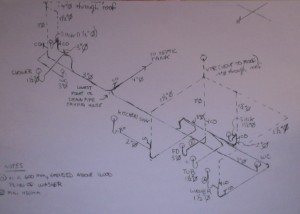
Hi, Darfield.
I’m an spanish architect inloved with the eartship concept and trying to adapt this into a new concept of bio-housing.
I enjoyed with your adventures an hope may be you were so kind to bring me some help with my project, as an expert.
Nice family,
Ciao,
I’m very impressed by your build and I’d love to see it sometime.
I am planning to build in eastern Ontario in Lanark county and i was searching for any earthships around the area which there are two in the Bancroft area but they seem to be at the one end of the spectrum but for me some new modern additions is essential so i started looking for plans and I stumbled on to your site, I would like to know if you would be interested in sharing your plans as a template for my build as I went to Earthship and WOW I was a bit shocked at the costs associated with there plans, I can certainly tell your hard work and dedication to this project was a a great success and I would like to commit to the same goals for my family.
Please let me know if you would be willing to share your plans or if i may purchase the final designs.
I would have use the same architect for additional changes for my Ontario code requirements though
Thank you
Hi Christopher,
We have shared PDF files of our plans on this site for reference only.
We have not provided dwg files of the plans for a few reasons; the plans were made with Architectural Desktop using proprietary extensions from Hsb-Cad … these extensions make the plans difficult to share, the plans are unique to our site and do not account for issues specific to someone else’s site (snow load, earthquake requirements …) and we learned a lot as we built that is not all reflected on the plans as posted as this is the first building like this we have ever worked on (mostly in grey water layout but also in other areas).
Good luck with your project and we are always open to questions,
Chris
earthship/sandbag/timber/greenhouse project .I will be starting my layout soon ,I’m building on the canadian shield and will be doing this project in an unorganized and unincorperated twp I will be putting sandbags instead of tires as I have allergies to them .I will mix up a footing at 4000psi and the sandbags will have portland mixed in them with some SS rods and big carton binders plastic at 2200lbs strength and steel fencing in the floor and on the walls with lime cement/adoby.in the floor pex pipe to a compost pile with pex in it as well for heating the floor,i will use black water as the starter and will let it go after the winter and start a new one for summer and start new one for winter again so I will have six or 7 piles after a time and will reuse the pex after three year.I will have two wood stove a cook stove and wood stove for heat as I want to add a berm to the north ,north west sides and will have the south side as greenhouse,will use saved water in a cistern to save water for everything with a small filter that will run to fill a 55gallons for drinking.all lighting will be D.C. off solar and 400w windmill at 30 ‘hi.with battery’s and a 3500w gen backup.I think it will take me a year,with my backhoe and 12cu concrete mixer and 2500 sandbags if people want to learn more and would like to help me e mail me at likeher@live.ca Bob